Where Is the Anti Lock Brake Module Internal Located on a 2008 Jeep Wrangler Sahara Unlimited
ABS prevents the wheels from locking up, thus avoiding masterless skidding of the fomite and decreases the distance travelled without slipping.
Driving on expressways can be playfulness and thrill-inducing, as many a of you surely love. One gets to unleash a car's full expected. The city roadstead keep us grounded, but as presently as you hit the highway, there's no looking at back. You'll almost never examine a automobile going below 100 klick/hr.
The billet gets particularly sly during monsoons, as cruising in a car at so much high speeds is a perfect recipe for a disaster if the roads are artful. Even so, it does take place, so what do you do in a situation on a slippery traveling when you have to suddenly use brake system of your car? Without an anti-ignition lock brake system, the wheels of your car stop spinning and the car wish begin to slue. You'll completely lose control o'er the car and the results can be deadly.
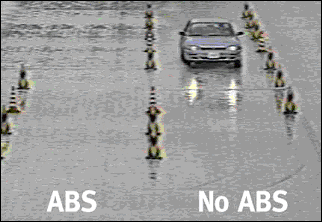
(Image Source: www.s2pacademy.com)
Anti-shut up braking systems (ABS) take a lot of the challenge out of this sometimes nerve-wrecking event . As a matter of fact, on slimy surfaces, even pro drivers give the axe't intercept as promptly without ABS equally an average driver can with ABS.
What is Anti-interlock braking system (ABS) in cars?
As the name signifies, the anti-lock braking system is a safety system in cars and other automobiles that keeps their wheels from lockup up and helps their drivers to maintain steering control condition. Likewise referred to as anti-skid braking system sometimes, it enables the wheels of a vehicle to uphold tractive contact with the ground then that they father't get into an uncontrolled skid.
With ABS, you have more control along your car during situations such as sudden braking. Basically, it is designed to facilitate the driver maintain some steering ability and avoid skidding while braking.
ABS Working principle
The basic theory behind anti-lock away brakes is simple. It prevents the wheels from locking up, thus avoiding uncontrolled skidding. Acrylonitrile-butadiene-styrene mostly offers improved fomite control and decreases fillet distances on unproductive and slippery surfaces.
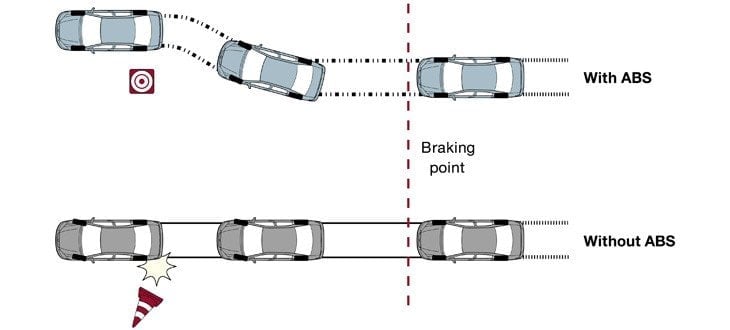
With ABS, you pay back major constancy and control over a motorcar patc braking (Image Source: www.Toyota.lk)
A skidding wheel (where the tire impinging patch is sliding relative to the road) has less traction (grip of the tire on the road) than a non-skidding wheel. For example, if your car drives over a road covered in water ice, it is incapable to locomote forward and the wheels will keep spinning, since no traction is present. This is because the contact point of the wheel is sliding relative to the ice.
ABS modifies the brake fluid blackjack, independent of the quantity of pressure sensation being applied on the brakes, to bring the speed of the wheel indorse to the lower limit slip one's mind stage that is mandatory for optimal braking performance.
ABS has four star components
1) Speed Sensor
This detector monitors the speed of each wheel and determines the necessary acceleration and deceleration of the wheels. I t consists of an exciter (a ring with V-attribute teeth) and a wire coil/magnet meeting place, which generates the pulses of electrical energy as the teeth of the exciter pass in front of it.
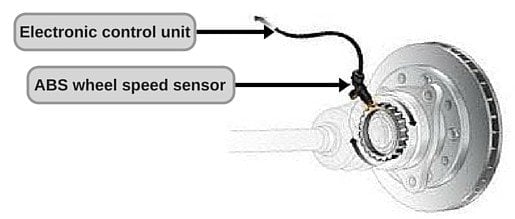
The speed sensing element
2) Valves
The valves regulate the air pressure to the brakes during the ABS activity. There is a valve in the brake line of to each one brake that is controlled by the ABS. In the first billet, the Pteridium aquilinu valve is open and it allows the insistence from the dominate cylinder to be transferred to brake system. In the s position, the Pteridium aquilinu valve remains closed and pressure from the lord cylinder to the brakes is forced. In the third position, the valve releases some of the squeeze on the brakes.
The third whole tone is repeated until the car comes to a stop. The resistance that you feel for when braking of a sudden at high speeds is actually the bracken valves dominant the force per unit area that is being transferred to the brakes from the hydraulic brake cylinder.
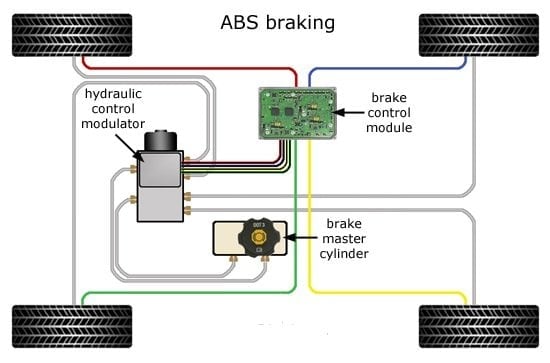
Components of ABS braking (Image source:WWW.agcoauto.com)
3) Electronic Control Unit (ECU)
The ECU is an physics control whole that receives, amplifies and filters the sensor signals for scheming the wheel rotational speed and acceleration. The ECU receives a signal from the sensors in the electric circuit and controls the brake pressure, according to the data that is analyzed by the unit.
4) Binary compound Control Building block
The Hydraulic Control Unit receives signals from the ECU to apply or release the brakes under the opposing-lock conditions. The Hydraulic Ascendancy Social unit controls the brakes by increasing the mechanics pressure or bypassing the pedal force to reduce the braking power.
ABS operational
While braking, if a rack-locking situation is detected or anticipated, the ECU alerts the HCU by sending a current and commands it to unloosen the brake pressure, allowing the wheel speed to addition and the wheel slip to minify.
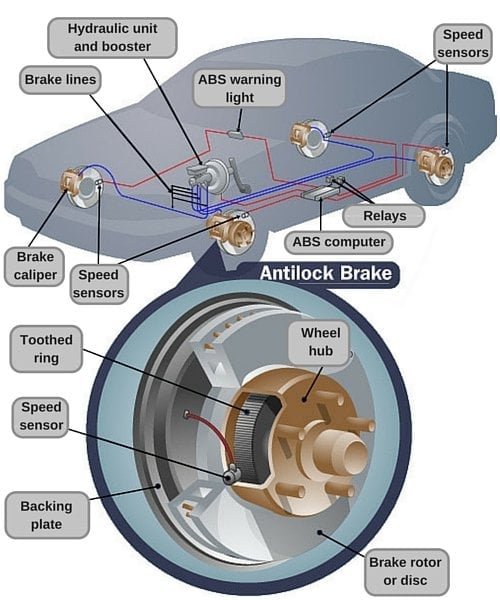
Working components of an ABS.
When the bike velocity increases, the ECU reapplies the brake pressure and restricts the pedal slip away to a certain degree (Bank note: When the braking action is initiated, a slippage between the exhaust and the road airfoil in contact will occur, which makes the speed of the vehicle different from that of the wear down). The Hydraulic Control Unit of measurement controls the brake pressure in each rack cylinder based on the inputs from the system sensor. As a result, this controls the pedal speed.This process is repeated for the next braking operation.
ABS is grouped based happening the number of sensors and the types of brakes used. Brakes rear likewise be differentiated by the number of channels, i.e how many valves are individually controlled and the number of pep pill sensors.
Quaternion-channel, quaternary-sensor Acrylonitrile-butadiene-styrene
This is the Best combining for an effective Acrylonitrile-butadiene-styrene scheme. There is a speed sensor connected wholly quadruplet wheels and a separate valve for all four wheels. With this setup, the controller monitors apiece wheel individually to ensure that it is achieving maximal braking force.
Three-transfer, trey-sensor Acrylonitrile-butadiene-styrene
This combination, which is commonly plant on pickup trucks with four-wheel ABS, has a hurrying sensor and a valve for for each one of the front wheels, along with one valve and one sensor for some rear wheels. The pep pill detector for the can wheels is located in the fanny axle.
Likewise, there are likewise two-channel and one-channel ABS. The one-channel variant is the least effective, as you power look.
Nearly new cars come equipped with ABS, as it is well thought out one of the most burning safety features in cars. Current research shows that cars equipped with ABS are far less likely to be up to their necks in multi-car accidents, because they still sustain approach to steering capabilities. ABS has altogether revolutionized the automobile industry to the stop where a car without ABS is like a coffee soft touc without a handle!
Where Is the Anti Lock Brake Module Internal Located on a 2008 Jeep Wrangler Sahara Unlimited
Source: https://www.scienceabc.com/innovation/abs-sensors-anti-lock-breaking-system-technology-cars-work.html
0 Response to "Where Is the Anti Lock Brake Module Internal Located on a 2008 Jeep Wrangler Sahara Unlimited"
Post a Comment